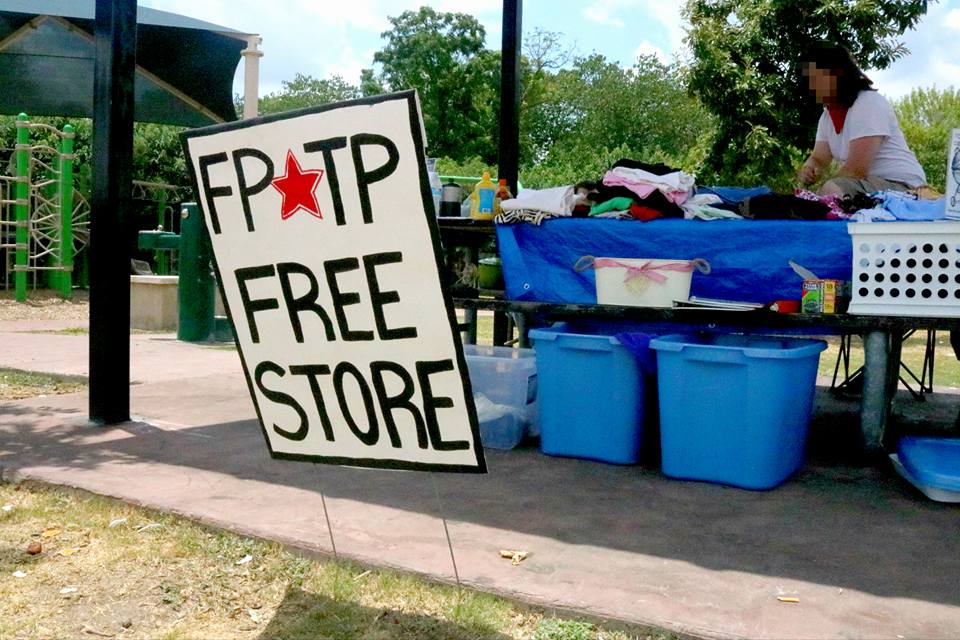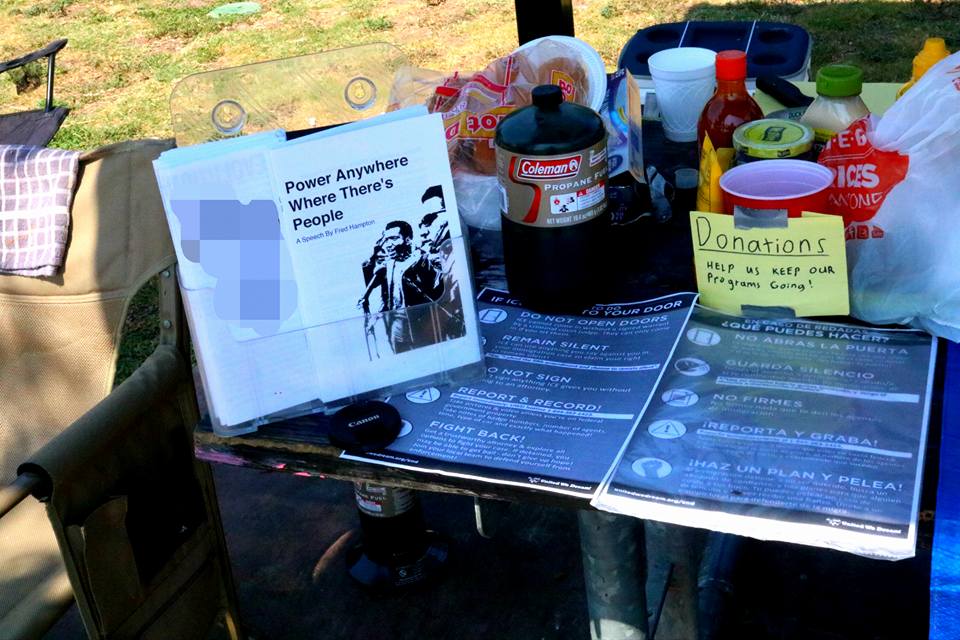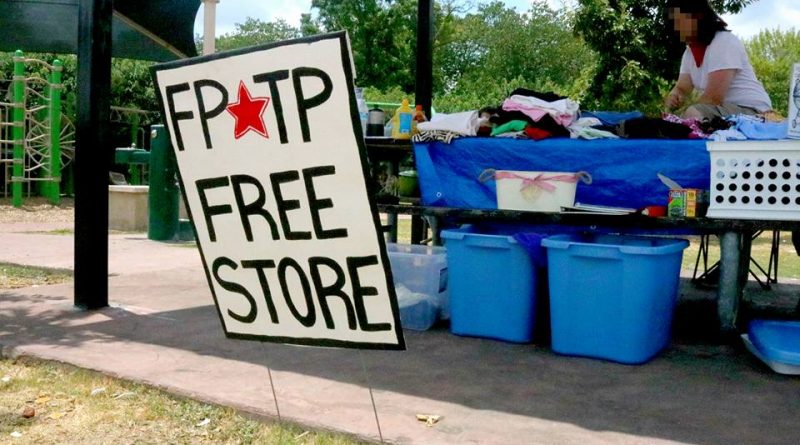San Marcos, Texas: Summation of Our Work at CM Allen Homes and Criticism of Errors Over the Past Year
What follows is a summation of our work in housing struggles in a San Marcos public housing neighborhood from July to November 2017 and criticism of our methods of work up until recently. We think that this document will be very useful to organizers – particularly ones with little experience – in small towns of “first-world” imperialist countries.
Our first attempt at mass work
After months of social investigation and study as a small collective of revolutionaries, in July 2017 we chose CM Allen Homes as the location to begin our commitment to mass work in service of the people. CM Allen Homes is a public housing community off of River Road on the East side of town. Working with and for the people, the masses, dedicating our lives to serving them is essential to leading them to taking power and holding it in war against the existing state by the creation of base areas. These base areas provide the recruitment base for an army of the people and the mass base for the people’s party that will lead us toward the final destruction of colonialism, imperialism, exploitation, oppression, and capitalism forever. Uniting with the people and mobilizing them is the only way we can win.
We enthusiastically jumped into our work with the guidance and support of more experienced local comrades. In the process, however, we also jumped into some of the same major errors common to the “left” in imperialist countries, particularly the US. Namely we fell into economism and a lack of leadership that fostered individualism and a lack of discipline and morale. We will discuss these errors later on in this piece.
Rationale and methods of work at CM Allen
There is no shortage of working class neighborhoods in San Marcos. Why did we choose this particular neighborhood? The major reasons we chose CM Allen Homes were twofold:
1.) CM Allen Homes, along with most of the surrounding area, infamously flooded on Memorial Day weekend in 2015. This was directly due to the irresponsible building of The Woods, an enormous student housing complex built on top of a floodplain and given a moat for its own protection. The construction of a large elevated structure adjacent to the San Marcos River has completely altered the hydrology, resulting in the surrounding area’s devastation. At CM Allen in particular, it flooded multiple feet into people’s homes, with a lone school bus arriving to rescue those stranded only after the water was well above its wheel wells. The masses of CM Allen and the surrounding area suffer more violence than most from the contradiction between the working class and Texas State University, which in its need to constantly expand and increase revenue, is relentlessly gentrifying San Marcos and pushing the working class out. Texas State University along with the city government are the driving capitalist forces in town. They represent the interests of the other capitalist forces such as developers, and should be considered the main enemy.
2.) CM Allen Homes itself is centrally located next to a small, popular city park – Conway Park – situated between mobile home parks and neighborhoods interspersed with petty bourgeois (middle-class) and working class people. Considering that there is somewhat of a shortage of popular working class spaces where visitors could gather (especially sober ones), this park seemed like a good public meeting place. Conway was also free of the questionable politics of certain other places where we would need permission from established, self-congratulatory left-liberals more interested in their own careers and serving their capitalist masters instead of anything like serving the people.

Having found our area, FPTP launched in August with the first in a series of monthly free stores and servings at Conway Park. There we grilled hamburgers and hot dogs, provided cold water, and offered revolutionary literature along with items like toiletries, clothes, kitchenware, and especially (at the first one) school supplies gathered from comrades, friends, and community members – all free – with the intention of bringing residents out, getting them together and all of us talking together with us using the mass line. The mass line method of leadership is the only correct method we have of leading the people. It’s correct because it gathers the ideas and problems of the masses, refines these ideas with revolutionary science and brings them back to the masses as programs, campaigns, and initiatives. When the people take up these programs and initiatives crafted from their very own ideas, they become weapons for the people’s liberation.

We advertised with flyers in nearby businesses that the working class frequent like laundromats, convenience stores, grocery stores, and working class restaurants. We also attempted to post flyers up in neighborhoods, but we soon gave up this practice, possibly prematurely, when we found out that San Marcos city employees very quickly take them down. One person claiming to be a city employee in fact pulled up in their car to tell us not to put any up. While this on its own didn’t stop us, we found no particular advantage in doing so, at least in the neighborhoods we tried it in.

What quickly proved to work best in establishing contact with the masses, as repeatedly demonstrated by other revolutionary collectives, was going door to door in CM Allen itself; engaging and discussing with the masses what their problems and ideas for solutions were. We talked to a lot of members of the masses this way, but had comparatively little success in bringing adult tenants out to our events. Every time we set up at Conway, however, we always had a lot of the neighborhood kids come and hang out with us. The revolutionary future belongs to the young, and the kids’ willingness to openly and angrily talk about the problems in the neighborhood – something they largely only hear their parents talk about in private or individually – beautifully showed us why that is. In fact, speaking with the kids who came to our servings played a crucial role in our outreach to adults. We were able to take the information they gave us about the problems in CM Allen and use it to initiate engaging conversations with people who did not yet have a reason to trust us. By our demonstrating some familiarity with their plight upon meeting, members of the masses were much more inclined to open up to us about the conditions they faced
We held a few more servings up into October, mostly talking to either one mass contact at a time or cooking for the kids with occasionally the two combining. We made a few relatively solid mass contacts that we followed up with, though irregularly.
What did tenants there face?
We quickly learned by talking to tenants, mostly through one on one meetings and doorknocking, that regardless of being housed by the San Marcos Public Housing Authority, CM Allen was run with the same abuse, neglect, and ruthlessness of any average slumlord. While the SMPHA locally makes a mild show of having compassion and care for their tenants, through our research we found that PHAs operating as slumlords is a common occurrence across the country. Each PHA, while technically a government agency, has the ability under certain conditions to buy and sell property similar in effect to any private owner.
The face of neglect and abuse at CM Allen was (and possibly still is) Cam Parsons, the property manager at CM Allen who evicted tenants left and right while seemingly moving very few families in despite a 3 year waiting list. Eviction notices were often threatened to selections of different tenants at a time based on arbitrary and harsh enforcement of the most trivial of violations. Having a grill or patio furniture outside or some cigarette butts on the ground was apparently enough to make a family homeless. Tenants generally feared going outside, and hardly anyone talked with their neighbors. On weekdays kids often came out to play, but only after Cam left at 6 PM. Multiple tenants had attempted to complain but Cam showed disinterest and even hostility to these attempts, even going so far as to calling the cops on one indignant resident.
Multiple tenants reported maintenance workers being possible spies on Cam’s behalf – showing up uncalled for and finding technically actionable infractions on tenants while dragging their feet on real problems that affected tenants. We even heard one report of a maintenance man coming unexpectedly and not leaving nor looking away while a woman changed. Mold from the Memorial Day floods was also still common. We were told that in many places it was simply painted over, a fitting metaphor for San Marcos and it’s Public Housing Authority’s hypocrisy.
Criticism and Lessons
While we gathered a lot of details and grievances from individuals and made a few mass contacts, we never were able to mobilize the masses with any popular campaigns or ideas forged from their struggle. Essentially, we failed to properly apply the mass line, got wrapped up in economism, and suffered from a lack of formal leadership.
Our servings and free stores right from the start suffered from economism. We got wrapped up in the various tasks of each store, and producing food or goods became a way to exhibit to ourselves that we were in fact ‘serving the people’ and ‘doing good work’. All the while, we were often missing or making secondary the political aspect – the very point of the work in the first place. This is the essence of economism. Just as STP-LA works to avoid, when we focused on offering services first people would come up and look, take some items and talk to us very little. This misplacement of priorities was most obvious (in hindsight) when we launched with a school supply drive. We certainly helped fill a need for a small crowd of people, but barely any conversation whatsoever was even started and they cleaned us out of almost everything within the first thirty minutes. Decent conversations about problems in the neighborhood did occur, but were comparatively rare and, once again, were largely secondary to the running of the serving itself.
How have we avoided these errors in our current practice? The answer is that it is an ongoing struggle to combat economism in practice and keep politics in command. At all times we must be asking ourselves: does the path we take, the tasks we complete, the initiatives we put forward, and the leadership we provide bring us closer to mobilizing the masses for revolution by correctly using the mass line? Or does it merely meet a demand and could be called ‘good work’. Ultimately, economism is an error that goes to the right. It simply follows what the masses already want within the limits of capitalist reform instead of organizing them to rip down the system itself. It settles for immediate demands while calling these things in and of themselves ‘revolutionary’. With everything we do, we now struggle for unity with the masses toward the red line, the line that moves us closer toward building militant people power and settling for no less. This may mean slower growth, but as we’ll explain later, the solidity of our organizations members and of the members of the masses we bring in is what makes up the real substance of our organization. A militant organization of a few with the correct line and practice is worth infinitely more than any liberal organization or non-profit made up of thousands, because ultimately they can only betray the people. With solid formal organization, discipline through democratic centralism, and the correct line, we will bring the people to our side. We won’t just have numbers, but a party and an army and a united front ready to win the world.
Towards the end of our time in CM Allen we attempted to rectify our economism by focusing more on individual meetings with our mass contacts where we talked about and documented the problems they faced, attempting to fire them up to collaborate on solutions. Yet we did this with increasing irregularity. The seemingly complete lack of momentum in the struggle gradually wore us down to where our trickle of activity in CM Allen ceased altogether. The reason for this leads to discussion of another error.
The major reason our practice at CM Allen stopped was due to a kind of horizontalism and implicit rejection of the need for individual and collective leadership. While we embraced the democratic aspect of democratic centralism, we did not embrace the whole and our organization failed to become truly centralized with a unity of purpose, action, and initiative and clear leadership keeping us accountable. The lack of defined, elected, leadership allowed for liberalism in the form of individualism. Without leadership holding ourselves accountable, our collective discipline weakened as well as our initiative in the face of failure or minor setback. When a practice fails it needs to be examined critically through our revolutionary politics and either changed or dropped altogether. Sometimes failure doesn’t come from the practice itself being incorrect but from a failure to carry the practice out correctly, effectively, or in this case, to its end – a failure of leadership to keep up initiative and discipline.
While adult tenants, due to miserable material conditions, showed an almost complete lack of any internal cohesion as a community and a general unwillingness to come out of their homes and interact with neighbors they didn’t know, it is our internal cohesion as an organization that is always decisive and these difficulties could have been overcome. No matter our size, with correct and solid political line and leadership to make sure that line is carried out, we can overcome anything and win. Had an elected, proven, active leader along with elected committee leaders in charge of different areas of work brought us to stick to our individual meetings with more energy and consistency we may have made much more headway. Had our initiative remained we likely could have gradually formed smaller groups of mobilized tenants to serve as the kernel of bigger ones.
This error in leadership also manifested in our generally poor follow-up, relative lack of consistent communication with contacts (which continued purposelessly and undirected after our work in CM Allen came to an end), and sometimes lackluster, nervous doorknocking where we failed to hit nearly as many places as we could have and thus failed to engage with that many more people. Speaking to the first example, our increasing lack of communication led to contact dropping off without much of any attempt to keep it nor an explanation given to tenants. Without disciplined, encouraging leadership, members often approached doorknocking and occasional other tasks with a lack of enthusiasm more akin to an employee or someone begrudgingly working off their requisite community service. This weakened our efforts, in turn further decreasing morale and, ultimately, greatly hindering our efforts to serve the people and raise them into a revolutionary fury capable of moving mountains. If the so-called revolutionaries who are supposed to inspire and lead the masses in their struggle had no leadership of their own and approached this glorious mission like some arbitrary task they had been assigned to, why should the masses feel any more enthusiasm about it? Since then, we have elected both individual leadership and collective leadership in order to rectify these errors by holding members accountable to tasks and initiatives being completed and taken up respectively. This new structure also allows for explicitly provided guidance, and synthesis of experience, ideas, errors, and successes, plus thoughts to fix problems and keep us moving down the revolutionary path.
While it is disappointing to fail, there is always something to be taken from failure. Being a new collective we made many mistakes and suffered an early defeat, but we have learned many lessons.
We think that we can eventually turn our initial failure into a temporary retreat. Red base areas are taken through mass work and escalating confrontation with our enemies–landlords, gentrifiers, racists, capitalists, fascists and reactionaries. This is how red power builds and spreads. CM Allen is, unquestionably, a place where red power can grow, but our work and material conditions will determine when this will occur.
Source: https://fptpsmtx.wordpress.com/2018/06/01/summation-of-our-work-at-cm-allen-homes-and-criticism-of-methods-of-work/

